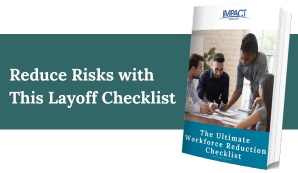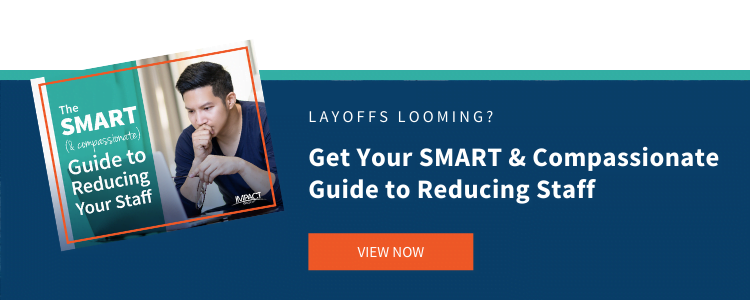How do you measure success in offboarding? Savvy companies today approach offboarding in a “strategic, data-driven and flexible way” according to the Harvard Business Journal. “A well-managed offboarding process can turn employees into loyal alumni who become customers, suppliers, boomerang employees… and ambassadors for the firm,” writes professors Alison Dachner and Erin Makarius in the April 2021 issue of HBR.
The 4 Rs: Value Drivers of Employee Alumni
It’s important that your ex-employees think highly of your brand. Here’s why:
- Revenue – Your former employees are likely to stay in your industry and take a new job with one of your customers or suppliers. You would rather keep them as brand ambassadors rather than detractors.
- Referrals – Particularly in the B2B world, employee alumni often have niche domain expertise. Others seek out their opinions and connections when they are buying your products and services.
- Rehired Talent – Rehires are 40% more productive in their first quarter at work, and they tend to stay in the job longer. Your employee alumni may go back to school or gain valuable experience in a different job, making them attractive to you once again.
- Reinforcement of Your Brand – Many employee alumni are active on social platforms and alumni networks. Even if they aren’t actively sharing content, they’ll likely be asked their opinion of your company and its products.
Employee Alumni Networks
Back in 2009 before social platforms were as strongly rooted in our culture, the University of Twente’s study found that 15% of companies they surveyed had formal alumni networks, while 67% had informal, employee-organized groups. Even if you aren’t cultivating or supporting an employee alumni group, it doesn’t mean someone else isn’t. Chances are, there is a Facebook page dedicated to your former employees.
Deloitte invests considerable effort to develop “colleagues for life” – which is how they refer to their employee alums. A recent visit to the career-alumni section of Deloitte’s website reveals career coaching tips, virtual networking events and even a webcast featuring Arianna Huffington.
Your brand disciples are out there – and they will be known in many circles as “Ex-ABC Corp” men and women. Customers and prospects look to them as “ex-insiders” whose opinions carry considerable weight.
Which storyline would you prefer: “Amy is an ex-ABC Corp alum and she swears by their technology.” Or, “Amy used to work at ABC Corp and she says she wouldn’t buy water from them if she was on fire.”
By investing in your alumni, you are tapping into a golden branding opportunity – the two-way street that we at IMPACT Group call the Employer-Employee Brand Ecosystem.
The Symbiotic, Employer-Employee Brand Ecosystem
Procter & Gamble (P&G), the consumer brand kingmaker of Tide, Cheer and Pampers, reportedly has the No. 1 employee alumni network.
P&G likely understands the symbiotic ecosystem of employer and employee branding. Today, successful job hunters market themselves by building personal brands – their own “employee brand” that aligns with the hiring manager’s vision of the ideal candidate. How do you build a great employee brand? One way is to showcase great employer brands on your resume. The stronger the employer brand, the higher the price (compensation) employee alumni can command.
Outplacement Coaching Builds Your Employer Brand When Offboarding Talent
At IMPACT Group, our career transition coaches teach former employees about the brand ecosystem – and why they should refrain from denigrating their former employer. Specifically, we help former employees understand that, by trashing their old company brand, they can in effect tarnish their own personal brand.
As an example, imagine a candidate with a resume documenting a 12-year stint with Employer X. As she networks and interviews, if she persuades others that Employer X was a poorly managed company with antiquated technology and bad management practices, she has just branded herself as someone who spent 12 years where she had no real learning, coaching or professional growth experiences. Conversely, when you extol the value of employer brands on your resume, by extension, you create a stronger personal brand.
Offboarding & Involuntary Separations Require Strong Outplacement
In situations of involuntary layoffs, outplacement should be a key component of your offboarding program. For most people, finding another job is almost always the biggest concern in these situations. Even if you don’t have enough budget to hire Arianna Huffington for a webcast, your more modest investment in outplacement – as long as it’s a quality program – will go a long way in preserving your brand.
Here’s why: Research by behavioral scientists suggests that what happens at the end of someone’s employment will likely overshadow the entire experience. Scientist and Nobel Laureate Daniel Kahneman’s uses his “peak-end rule,” to summarize his conclusion: people judge an experience by how they felt at its highest level of intensity – its peak – and at its end. And these feelings tend to cloud out the rest.
Peak Intensity of Involuntary Layoffs
For some people who weren’t expecting to be laid off, the shock of the event may easily represent both the peak intensity of their employment experience – as well as its end. After offboarding, they often struggle to find new work while carrying the weight of many negative emotions: shame, guilt, resentment, humiliation and even grief as they cope with job loss and the loss of socialization, purpose, identity, healthcare benefits and, last but not least, income.
The sooner these alumni move into a new satisfying role, the better for everyone concerned. However, today’s job search process is more complex and technology-driven than ever. And there’s the emotional battle. Most people haven’t had formal training to develop enough emotional intelligence and resilience to conquer the profoundly emotional loss of a job.
They need support to frame the situation positively and conduct a productive job search. Without a professional coach, who has experience helping people develop emotional intelligence, as well as their personal brand, your ex-employees may stall in their efforts. Without support, even star employees aren’t likely to get back into the workforce or get out from under the weight of so many negative emotions.
Differentiating High- vs. Low-Quality Outplacement When Offboarding
A good outplacement firm coaches your employees so they find fulfilling jobs. Or, it can help them explore a new “next step” in their career. This might mean retirement, entrepreneurship, volunteerism or gig work. But if the outplacement service is light on value, with little direct coaching, your employees may feel even worse about the separation. When the quality is poor, you’ll often hear, “I got outplacement, but it was nothing more than a website. After 10 years, this is how they treated me.”
Conversely, if the employee is impressed by the expertise of the outplacement coach, he or she is likely to view the situation positively. When employees perceive value, they are more likely to as think more highly of their former employer – and act accordingly.
Value Employees Through Action, not Rhetoric when Offboarding
However, some employers miss the point. They opt for the lowest cost outplacement they can find, which means their employees don’t get help from a professionally trained coach. Some programs offer a website with self-serve resources, which might include on-demand coaching. Most employees have little knowledge of outplacement or this type of coaching and its benefits – so they don’t ask for coaching. That may be a great way to minimize costs, but it does little to minimize the risk to your brand.
Simply stated, this “check the box” approach doesn’t work. When employees don’t get help managing their emotions or see results from their job search efforts, they are likely to trade down to a new level – an active and highly motivated brand detractor.
Smart employers understand the value drivers of employee alumni: The 4 Rs – revenue, referrals, rehiring and brand reinforcement. These well-run organizations invest in quality outplacement. As one executive with Grainger explains, “We’ve used other outplacement firms, many of them offer services by way of rhetoric,” commented Hank Galatz, associate general counsel at Grainger. “Unlike the others, IMPACT Group delivers a strong experience and high value, demonstrating that Grainger values all employees – including those who are leaving.”
For more information about outplacement programs, visit us here.
Sources:
Turn Departing Employees into Loyal Alumni, HBR
Why Companies Should Stay Connected with Ex-Employees, SHRM
Top 10 Global Alumni Programs, Enterprise Alumni
Cultivating Ex-Employees, HBR










